Artificial Intelligence vs. Machine Learning: Differences, Use Cases, and Implementation
Companies trying to get in on the AI hype have quickly rebranded ML solutions as AI. However, the lines between these two technologies are also blurred.
 January 26, 2024
January 26, 2024 11 minute reading
11 minute reading
Artificial intelligence (AI), machine learning (ML), data science, and big data. Is there a difference between these solutions?
Absolutely.
Yet, most users label these tools as artificial intelligence (even though they’re ML or data science software).
Why does this matter? Because the type of technology you use will affect the results you get. So in the end, it can hurt your outcomes and your bottom line if you choose the wrong tool.
Let’s dive into what AI and ML are and how you can use each to succeed in your business.
Find an AI machine learning expert on Fiverr
What is artificial intelligence (AI)?
We can loosely define artificial intelligence (AI) as any computer system that performs tasks that historically have required human intelligence.
Data scientists break AI down into three general levels:
ANI: Artificial Narrow Intelligence
AGI: Artificial General Intelligence
ASI: Artificial Super Intelligence
ANI: Artificial Narrow Intelligence
At this level, AI performs specific tasks without the ability to reason and broaden its knowledge. All existing AI used today fit into this category, including ChatGPT.
ChatGPT may appear conscious and able to reason about facts. However, under the hood, it works purely through complex layers of mathematical algorithms that predict the next word in a sentence. ChatGPT can’t draw conscious conclusions from its training data or any new data you provide.
ChatGPT falls into the ANI category because it handles one specific task excellently: Processing language and predicting output. ChatGPT has exceptional performance because of significant breakthroughs in natural language processing (NLP) and machine learning models, which we’ll discuss in the Generative AI section below.
Other examples of AI tools at the ANI level are:
Self-driving cars
Computer vision, such as Google Glass, which performs visual tasks such as recognizing faces
Warehouse robotics tools, such as those used in Amazon’s fulfillment centers
Voice recognition tools, such as Siri and Google Assistant
Speech recognition tools like Otter.ai that transcribe audio files and summarize them using AI
Financial forecasting
Fraud detection
Cybersecurity tools to detect anomalies in network traffic
AGI: Artificial General Intelligence
AGI refers to a version of AI that can reason and think, such as Data from Star Trek or C3PO from Star Wars.
“For a while, I strictly adhered to the idea that AI was defined as a machine that can think and reason for itself, which has now been classified as Artificial General Intelligence (AGI),” says Dr. Hagen Fritz, Research and Development Engineer at Rogers-O’Brien Construction. “What people call AI today is complex ML systems and rules that work together to create a fully automated system.”
Disagreement exists among experts about the precise definition of AGI. The team behind Google DeepMind—Google’s AI research lab—proposed new definitions of AGI to encompass the nuances that recent AI breakthroughs introduced.
In ANI, the AI system’s problem-solving and decision-making capabilities only encompass its explicit training. In AGI, decision-making and problem-solving abilities grow independently, much like humans gain increasing reasoning powers with the more data we have.
ASI: Artificial Super Intelligence
ASI only exists in science fiction novels. To achieve ASI, AI, and robots would achieve a level of knowledge far superior to human beings and essentially take over the world. This remains a highly theoretical level of AI.
What is machine learning (ML)?
Machine learning is a subset of artificial intelligence because artificial intelligence requires machine learning algorithms to work. Machine learning is the various technologies that perform data analysis using massive quantities of data, predict patterns, and determine trends.
“ML is the ability of systems to learn patterns from data and make decisions, whereas AI is a system that can perform more complex tasks,” says Dr. Fritz. “ML is the backbone, providing the math, the rules, and the iterative process that allows AI services to churn out pre-formatted essays on any topic and exquisite photos of anything you can dream up that used to require human-like intelligence.”
Dr. Fritz believes we started calling these systems “artificial intelligence” because they appear to mimic cognitive functions.
By adding decision-making functionality to the machine learning solution, we can turn a purely ML solution into an AI one.
ChatGPT—an AI solution—became possible because of the underlying computer science and machine learning technology breakthroughs. Before AI can exist, computer scientists must optimize machine learning algorithms to make that AI possible.
The rise of AI and ML
The rise in interest in AI and ML prompted the Federal Trade Commission (FTC)—the USA’s consumer protection agency—to issue a warning against making exaggerated AI claims.
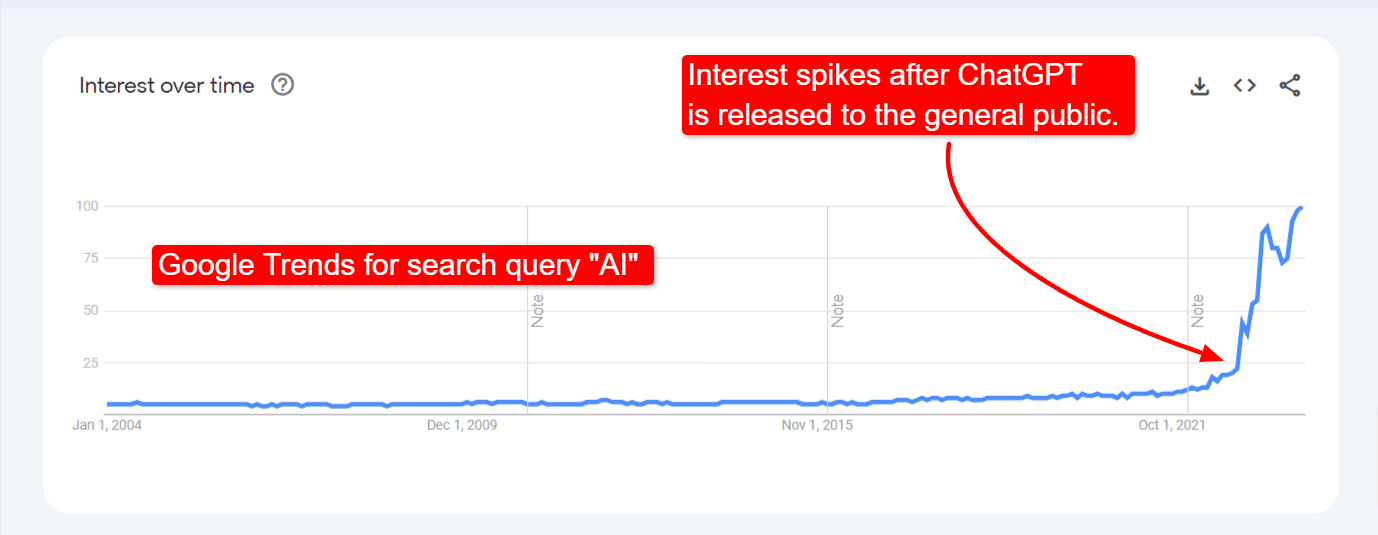
Google Trends showing an increased interest in AI.
Dr. Fritz states that his adviser always mentioned a humorous quote before starting the semester in his course: When you’re fundraising, it’s AI. When you’re hiring, it’s ML. When you’re implementing, it’s logistic regression.
“I believe the quote summarizes the marketing used by many of these ‘AI’ tools,” Dr. Fritz says.
Unfortunately, the answer to what AI and ML are has become blurred. The pat answer that “ML is a subset of AI” is no longer adequate, as these two technologies continue to grow and overlap.
However, understanding their meanings is vital to prevent you from inadvertently making false claims in advertising. It’s also important to know the full breadth of the terms to understand how to use each technology to improve your business.
“Reflecting on the recent strides in ML/AI research, I concede that these new tools coming out today are not strictly ‘AI,’ but they cannot be neatly classified as ML either,” says Dr. Fritz. “Thus, we need to give these tools a new name. They perform complex tasks with relative ease that, if a human were to do them, we would call it ‘intelligence.’”
What is generative AI?
Generative AI (GenAI) is a subfield of AI that creates new content, such as text, images, audio, and video. The underlying architecture of GenAI processes billions of data points from massive datasets, learning patterns, and trends, then it predicts output matching the patterns and trends of its input.
Various GenAI solutions exist, such as:
ChatGPT
DALL-E2
Midjourney
The age-old programming maxim of “garbage in, garbage out” applies equally to GenAI. When you feed a computer system poor data, it outputs poor answers.
One massive problem with existing mainstream GenAI solutions is that their training is predominantly on Western data, much of it containing unconscious biases, which the tools subsequently output when given a prompt.
Some workarounds exist to improve this, such as training ChatGPT on your own data. However, the problem remains prevalent, and the real solution lies in training the underlying models on real-world data encompassing all cultures and viewpoints.
Another workaround is to learn to talk better to ChatGPT to improve results.
You can also buy generative AI lessons from Fiverr freelancers if you’d like to improve your results with generative AI.
Far more sophistication goes into how generative AI works precisely. But to understand it, we must understand some of the core terminology of AI and ML.
Key terms in AI and ML
AI and ML are massive topics, and covering all the abbreviations and technical words would require a book. However, several words appear repeatedly in the news, or form fundamental concepts in AI and ML.
Our list of terms below can help you understand the topic better.
Data Science
Data science is a multidisciplinary field that attempts to extract meaning from data by applying programming, mathematics, statistics, and domain-specific knowledge.
A “domain” refers to a specific sector or activity.
Example: Data science is used extensively in healthcare to help medical practitioners to:
Diagnose diseases
Track patient health
Track the effectiveness of specific medications
Analyze medical images
Neural networks (or artificial neural networks)
Many websites fob off the definition of neural networks by saying they’re modeled on the human brain. These definitions serve little use because they don’t tell you what neural networks do.
To truly grasp a neural network, we need to define “neuron” as it’s used in computer science:
A neuron in computer science is a computational unit that processes multiple weighted inputs to produce a single output, typically through a non-linear transformation.
For example:
Imagine an artificial neuron as a tiny decision-maker that considers if it's raining and if it's the weekend, with more emphasis on rain, to advise if you should carry an umbrella. It multiplies the importance of each factor with its presence, sums it up, and if the total is high enough, it triggers a 'yes' for the umbrella.
A non-linear transformation means that the output doesn’t change in direct proportion to modifications in the input, allowing for complex output modifications when input parameters are changed.
For example:
Consider a dimmer switch for a light bulb: turning the knob slightly might not change the light much at first (non-linear), but as you keep turning, the light increases dramatically. This allows for fine control at low light levels and rapid brightening at higher levels, unlike a regular switch that flips the light on or off with no in-between (linear).
A neural network is a computational model composed of interconnected artificial neurons, where each neuron processes multiple weighted inputs to produce a single output through a non-linear transformation.
For example:
Think of a neural network as a team of office workers, where each worker (neuron) receives various tasks (inputs) with different levels of urgency (weights) and decides how much attention to give each task before passing on a decision (output). The workers' decisions are not straightforward; they consider the complexity and context of tasks (non-linear transformation), allowing the team to tackle intricate problems collectively.
GPT (Generative pre-trained transformer)
Transformers are a type of multi-layered neural network where each layer processes information and passes its output to the next layer. Unlike some other neural networks, each layer in a transformer can pay attention to different parts of the input simultaneously, which helps in understanding complex patterns, especially in language processing.
One significant benefit of transformers’ parallel processing capabilities is that the model can capture the context of the input far better than models that process data sequentially.
By “pre-training” transformer models on large datasets, they can generate textual output that matches the patterns of the input they were trained on.
Finally, “generative” means they generate output.
GPTs were the breakthrough that caused the current AI craze. The ability of GPT models to hold seemingly human conversations makes them ideal for building AI chatbots or other real-time conversational AI tools.
Natural language processing (NLP)
NLP is a branch of computer science focused on enabling computers to understand, interpret, and respond to human language in a valuable way.
NLP doesn’t always fall under the umbrella of AI. For example, spell-checking and grammar-checking tools use NLP. Search engines have used NLP for decades to extract meaning and read keywords on web pages.
More advanced uses of NLP cross over into AI, such as using NLP for sentiment analysis, text classification, and speech recognition.
Many powerful NLP libraries exist for the Python programming language, making it a popular language for building AI-powered apps. To test one of these libraries, type some text into the following NLTK (Natural Language Toolkit) website to see how NLTK perceives the text’s sentiment:
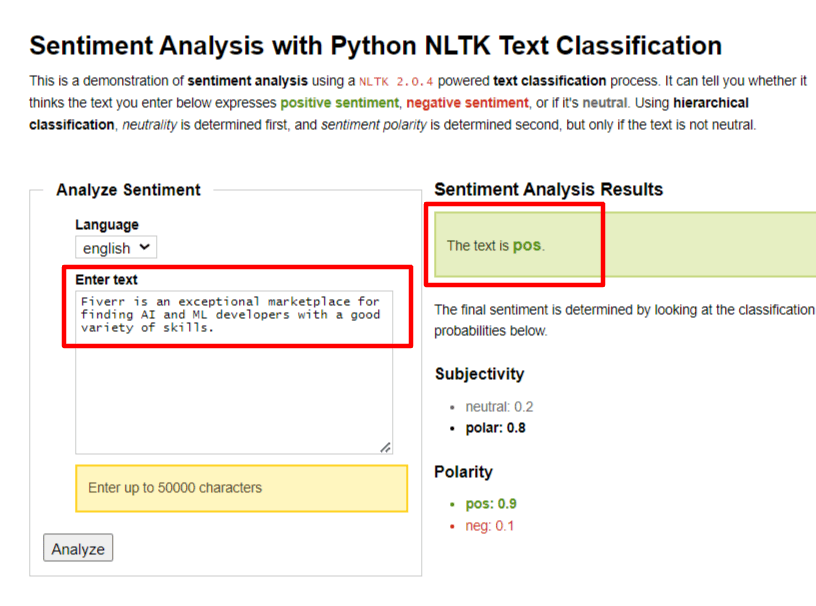
Example of positive sentiment using NLP in Python.
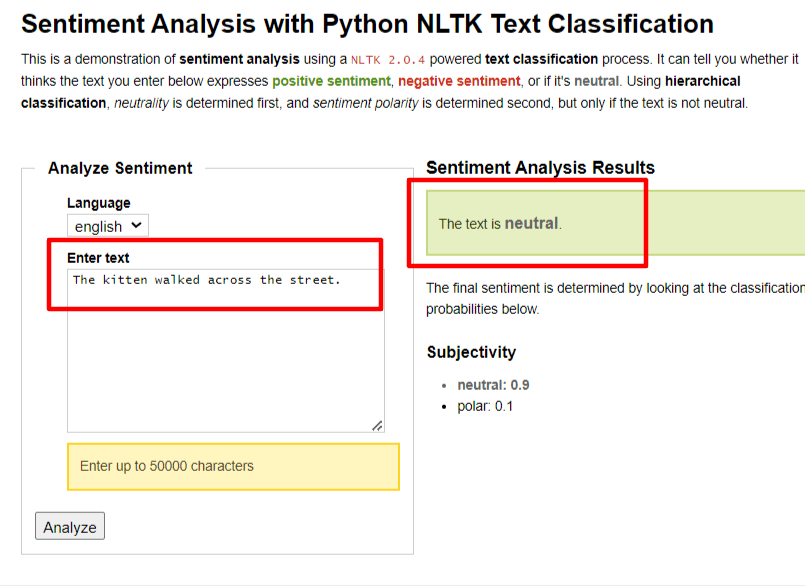
Example of neutral sentiment using NLP in Python.
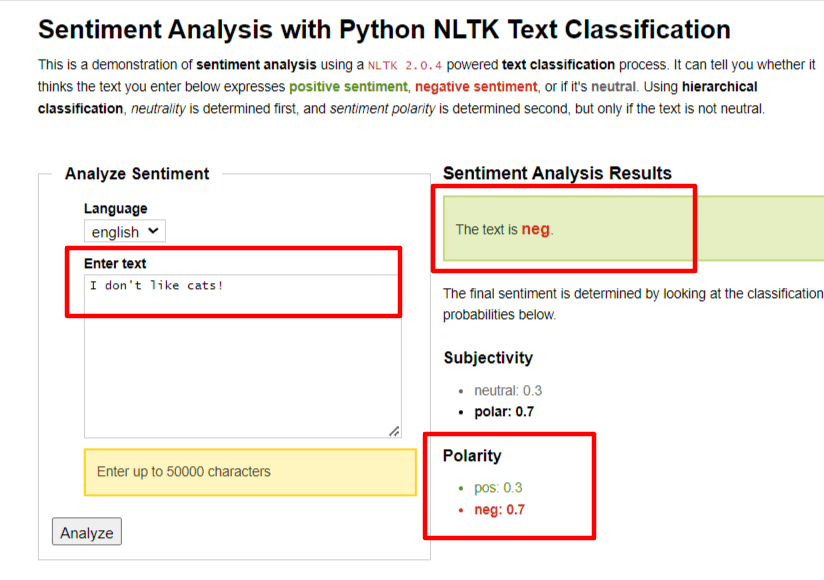
Example of negative sentiment using NLP in Python.
You can buy Python programming services from Fiverr expert freelancers if you’d like to create a similar solution for your business.
Machine learning models (computational models)
AI and ML rest on computational models.
Models are patterns used in computing and analyzing data to make decisions. Many models exist in AI, and choosing one model over another depends on your particular use case.
The most common model we’ve heard about in the news recently is the large language model or LLM.
LLMs are a mathematical and computational framework for processing, understanding, and generating human language. The most effective LLM for chat-like interaction is GPT.
Neural networks can also be considered a computational model.
Implementing a specific model type requires building the respective hardware and software to perform according to that model’s rules.
Supervised learning/Unsupervised learning
You can train machine models in two ways:
Supervised learning: A type of machine learning where the model is trained on labeled data. Humans curate the data and then feed it to the model: For example, providing millions of images with the text that defines what the image contains.
Unsupervised learning: Learning from data that hasn’t been labeled, classified, or categorized. The machine learning algorithm tries to identify patterns and relationships in the data.
Deep learning
Deep learning is a subset of machine learning involving neural networks composed of over three layers. It’s particularly good at learning from large amounts of data.
Deep learning makes it possible to train models using unsupervised learning, whereas traditional machine learning requires supervised learning.
Reinforcement Learning
A type of machine learning where an agent learns to make decisions by performing actions and receiving rewards or penalties.
OpenAI, the team that created ChatGPT, used all three learning methods to train ChatGPT—supervised, unsupervised, and reinforced learning. The team specifically used Reinforcement Learning From Human Feedback (RLHF). This learning method requires human curators who score answers from ChatGPT to ensure answers are as accurate and unbiased as possible.
Is a project AI or ML?
It’s becoming more challenging to clearly label a project as purely ML or AI.
During his graduate program in Civil Engineering at the University of Texas, Dr. Fritz created an ML system that acted as the “brain” of a smart light switch. Using reinforcement learning, the system learned the lighting preferences of someone in a single-occupant office with windows, automatically switching the lights on or off if that person’s lighting conditions were met.
He published the results in a paper titled LightLearn: an adaptive and occupant-centered controller for lighting based on reinforcement learning.
“The first paper on LightLearn is closer to AI, where a system is continually improving and learning from stimuli until something really powerful and reliable is produced,” he says. “I wouldn’t classify LightLearn as AI in today’s definition because the system requires user input to correct itself.”
How to implement ML and AI solutions in your business
Your AI business applications may include creating Python automation scripts that leverage access to ChatGPT APIs to develop a ChatGPT-powered chatbot. Or that connects to other cloud-based AI services to integrate AI into your business.
Another common use is building e-commerce chatbots to answer questions from ecommerce visitors. To develop an AI chatbot for your ecommerce store, you can buy AI chatbot development services from Fiverr freelancers.
Previously, hosting your own LLM required immense computational power and a DevOps team to set everything up. Now, you can host your own LLMs on cloud services, such as Microsoft Azure, Amazon Bedrock, or Google Cloud. You can buy machine-learning services from Fiverr experts if you’d like to train a cloud-hosted model.
Implementing AI into everyday workflows has become easier for small businesses because of the large ecosystem of services. You only need a programmer who can integrate AI into an existing application to create many apps to suit your business needs.
You can buy AI integration services from Fiverr experts to get started, or buy AI consulting services if you’re uncertain where to begin.
Get AI help from Fiverr experts
Fiverr is a marketplace of experts who can help you successfully implement AI and ML solutions in your business.
If you’d like to create your own machine-learning tools in C++ or Python, Fiverr has freelancers who can help you with that, too.
Getting started on Fiverr is easy—open an account, search for the service you’re looking for, such as “AI Chatbot” or “ChatGPT Applications,” and look through the results.
You can filter by seller details, service options, budget, delivery time, and more specific categories.
The results page shows you the seller ratings, price, and a brief description of what that seller offers. You can also filter results to include only Pro Sellers—handpicked sellers whom Fiverr has personally vetted for professional-grade service.
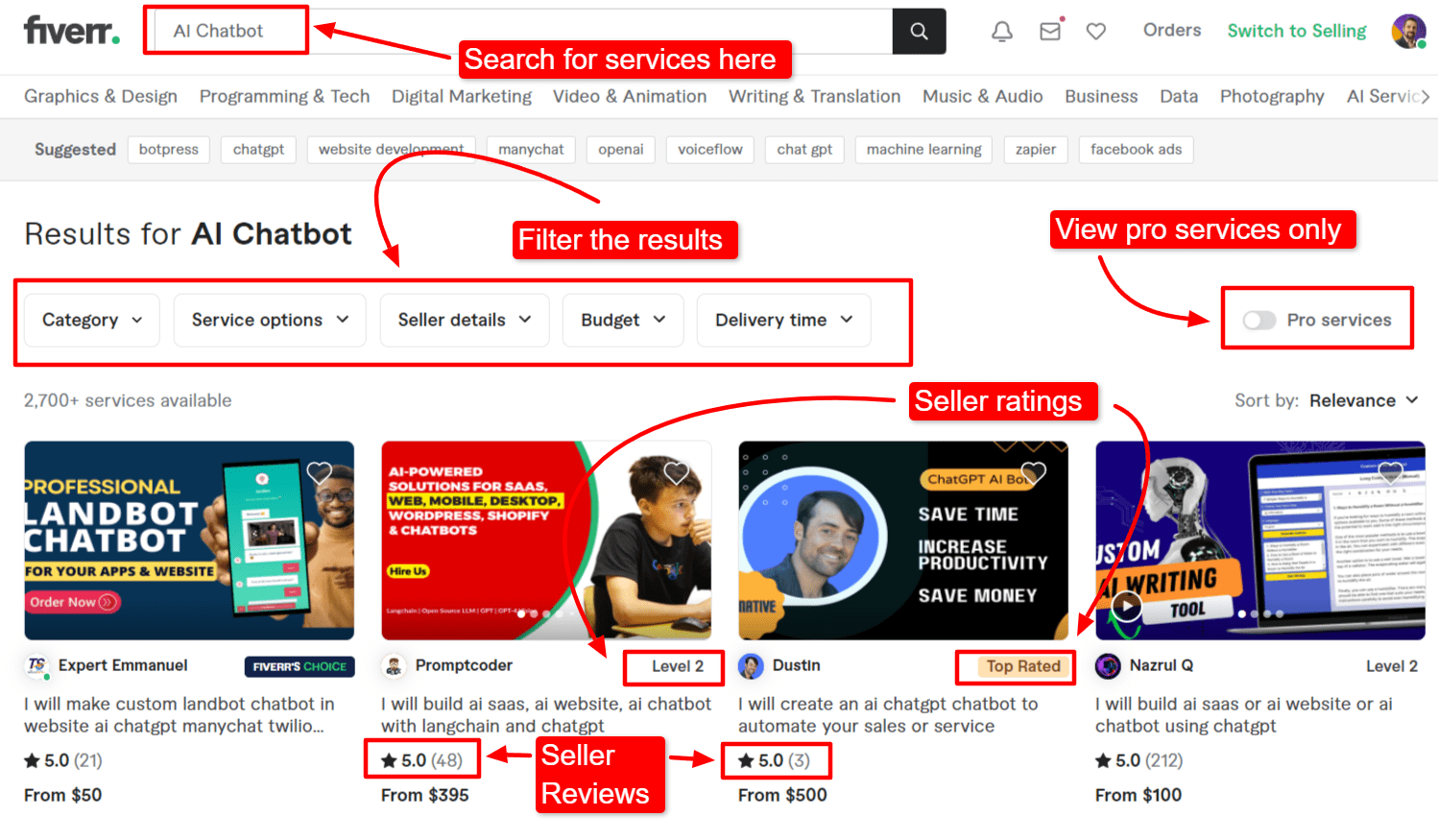
Annotated screenshot of Fiverr search results.
Contact each seller to discuss your project after making a shortlist of potential sellers. Our related guide to hiring a programmer offers various tips on what to look for when hunting for a great coder.
Fiverr’s Safety team watches your progress throughout your journey to ensure you and the seller have an excellent experience.
Find an AI machine learning expert on Fiverr
To get started, sign up for Fiverr today.



